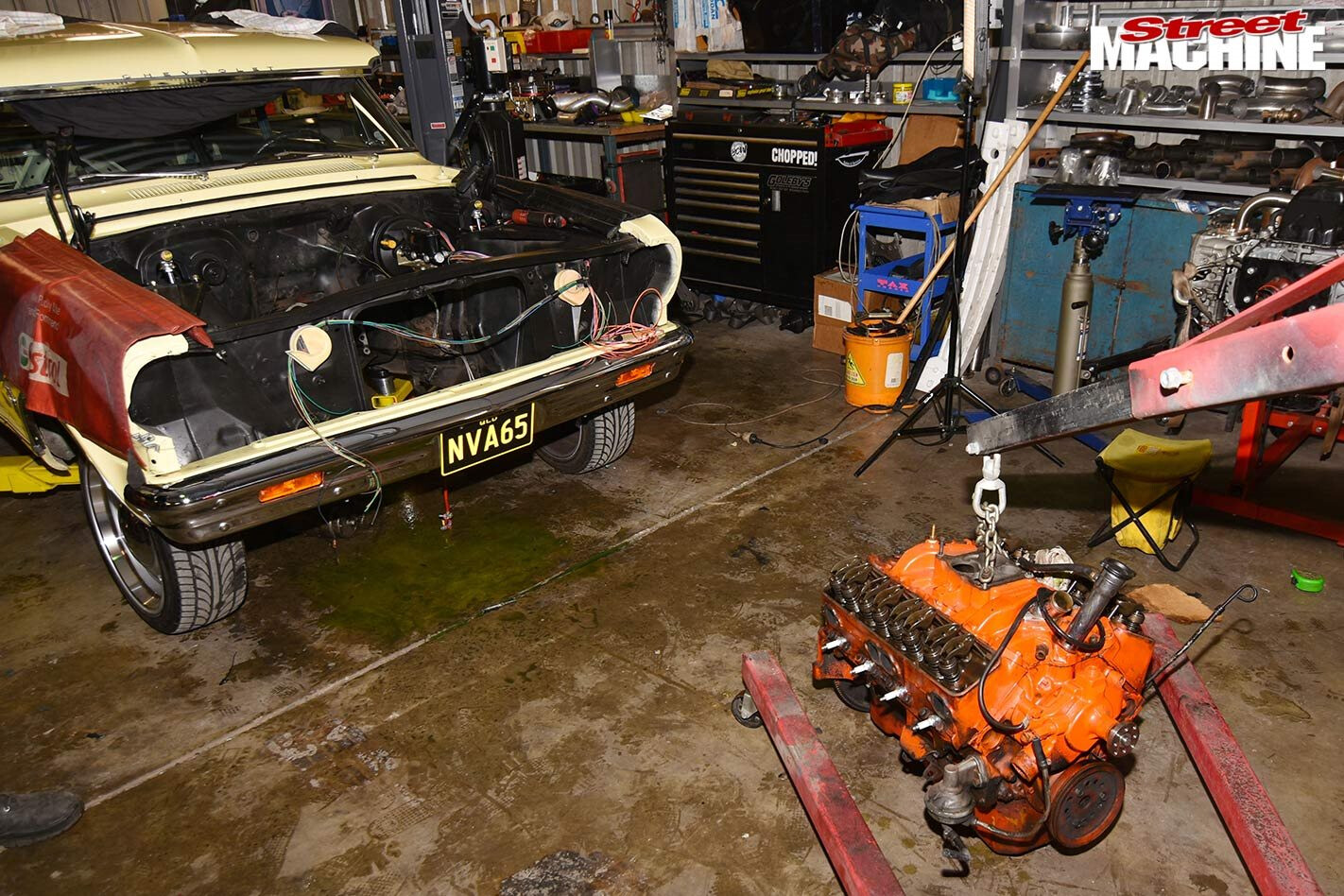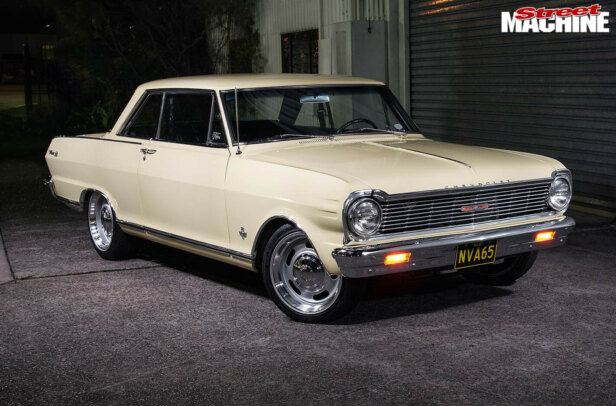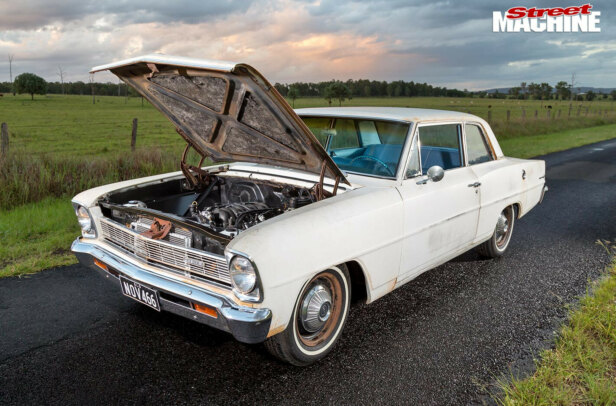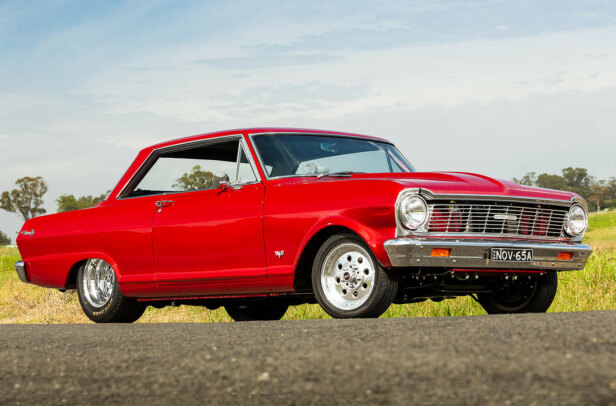OLD-SCHOOL muscle cars are awesome, but they don’t always make the best cruisers. Cam McEwen knows this all too well; his 1965 Chevy Nova SS wasn’t the best option to take out in the Queensland summers and suffered a few reliability quirks well-known to classic car owners.
He’d initially planned to update the original matching-numbers 283ci Gen I small-block Chevy with a Holley EFI kit, to keeping the old-school looks but lend the car more modern driveability. However, several mates got together and railroaded him into picking up a cheap 5.7-litre LS1 with the goal of disguising it to look like the original Gen I motor.
“The car has been great since I’ve owned it and generally reliable bar the usual old-car things like hard-starting some days, vapour lock and flooding, and heat trying to kill the starter motor,” says Cam. “I said I would never fit an LS, but at the end of the day, the cost, power, reliability and availability of parts were too much to resist. I found a great deal on Gumtree for the LS with the Holley EFI and was able to sell off various bits like the T56 gearbox and MSD 6AL ignition box to help offset some of the cost.”
Cam’s Nova already benefitted from a host of chassis upgrades from CPP, including weld-in chassis connectors, QA1 coil-over front suspension, and a beefy front sway-bar. The stock radius rods had been removed in favour of a CPP brace, and fatter 17x7in and 17x8in Wheel Vintiques Rallye wheels put on. On top of this, the front brakes are now Wilwood Dynalite four-pot discs with a Wilwood dual master and booster providing the squeeze.
Somehow I was cajoled into coming along to help add some LS perfection to Cam’s Nova, along with Al Butler and Ben Wood from Allied Performance Projects, and Aaron Fluegorhnhoeffer of Dunning-Kruger Motorsport.
CAM’S CAM
CAM’s Nova turned up to Allied Performance as a running, driving car, but his LS1 was purchased disassembled. It did come with some good gear, including an EFI throttlebody and matching single-plane intake manifold, and these would be the key to keeping the new-age small-block looking like the original motor.
As the cylinder heads and oil pan were already off, we decided it was a perfect opportunity to upgrade the camshaft and lifters, so I gave VCM Performance a ring to chat specs. With a 2800rpm stall converter, Cam wanted to have a bit of chop at idle and plenty of mid-range, but didn’t want to upset the LS1’s street manners too much, or go to the effort of fly-cutting pistons.
VCM’s Steve Tayler suggested the company’s #710 cam, which runs 232°/234° with a choppy 110° LSA, as the LS1 came with a single-plane four-barrel-style intake. Handily, the bumpstick turned up as part of a full kit, which included new lifters, matched pushrods, head bolts, ARP cam and crank bolts, timing chain kit and PSI valve springs.
This arrangement should deliver the 375-380rwhp that Cam ultimately wants. Achieving that power from the original 283 would have required quite a cranky set-up, whereas this LS1 will retain great on-road manners and a wide spread of power in the little, lightweight Nova.
We finished off the motor by fitting a front-hump oil pan, as the Chevy II and Nova platform seems to be the only old-school GM car to not run a rear-hump sump. Al had also wrangled a rear-hump sump from an H2 Hummer, but since this part was not required, Aaron took it and made a stein-holder out of it for his Messerschmitt KR200!
LITTLE AESTHETICS
AS THE small-block Chevy V8 has retained a basic 90-degree, pushrod layout with similar physical size through the ages, it’s easy to make an LS look like an earlier-generation motor just by spray-bombing the aluminium small-block in Dupli-Color Chevy Orange.
Now, we didn’t bother with a primer coat but we did give the engine a thorough wipe-down with brake clean before fogging the heck out of it. This was following advice from Aaron, who has painted several engines and at least one front bumper.
While the colour helped pass the LS1 off as an older V8, the modern plastic intake manifold and front-mounted throttlebody was never going to work. Thankfully, the engine Cam purchased came with a Holley 300-130 dual-plane inlet manifold, as well as one of Holley’s Terminator four-barrel EFI throttlebodies (550-405).
With a 4150 four-barrel flange matching common Holley carburettors, the 950cfm Terminator throttlebody houses four 840cc (80lb/hr) injectors, and the kits can even be purchased with controllers to operate electric transmissions like the 4L60E and 4L80E found behind stock LS V8s.
Having these bits as part of the engine purchase saved Cam a bucketload of money, though it cost him in other areas as the stock LS ECU wouldn’t be able to easily run the four throttlebody-mounted injectors. Thankfully, he was able to source a cheap, second-hand Haltech Platinum Sport 1000 ECU to have wired in.
‘I’d organised a pair of Tuff Mounts rocker cover conversion plates (MG602) for Cam’s Gen III motor, as they allowed him to reuse his original tin SBC covers. Doing this means you need to re-mount the LS1 coil packs elsewhere, though Tuff Mounts makes an LS1 coil pack relocation kit (MG010) to handle this, too.
Due to the size of the Wilwood booster, the left-hand ’65 rocker required a scallop to be cut out and welded in by Matt from Fiv3 Custom Metal. This wouldn’t impact the rocker arms, however, as the LS1’s rocker gear sits under the mounting height of the tin cover.
As the rocker covers don’t have an oil filler, Al dug through his stash of spares to find a metal filler neck from a 1980s Subaru Legacy, which he then welded to the valley plate. We also added fittings at the back of the valley plate to hook up breathers.
As a final step to creating the old-school look, the 283’s original air cleaner assembly was refitted, with a slightly taller filter element used to sneak some more fresh air in.
ANCILLARIES ANARCHY
AARON from Dunning-Kruger Motorsport rewired the car, as Cam had zero faith in the original wiring loom thanks to previous owners modifying it with varying levels of success. He did this separately to installing the Haltech ECU so that if the Nova ever becomes worth a king’s ransom and Cam decides to put the matching-numbers carby mill back in to cash out, he can do this without having to strip the entire loom.
Aaron and I fitted the sender unit and 250L/h electric in-tank pump to the brand-new direct-fit Holley EFI fuel tank (19-112) Cam had purchased. Buying the new tank simplified the fuel system in a major way as it saved cutting up the original tank, which was likely to have needed a professional clean-out and possibly repair work.
Amazingly, despite our years of past experience with bolt-in modifications, the tank kit fitted together easily and was able to be hoisted into the car after only half an hour’s work. Setting up the pump just off the floor of the tank only took a few minutes, while the float level arm required a bit of fiddling, as the unit had to be test-fitted several times to ensure good sweep, which affects how the fuel gauge reads.
One trap for young players we found was in pushing the bolts through the caps and the gasket material, which didn’t fit particularly well. After staring at it intently for several minutes in a disapproving manner, Aaron used his mildly impressive Teutonic strength to overcome the stubborn gasket and torque the bolts holding the fuel pump cradle and sender caps down.
With new fuel hose pushed onto the stock hard line at both ends, one Speedflow Pushlock fitting was added to the end of the Holley Terminator’s fuel rail, as the other end was capped off to run deadhead-style like a stock LS1. This buttoned up the fuel system.
BOLT-IN BANDITS
THE next step was to swing the motor into the car, but before we could do that, Aaron demanded the grime-covered transmission be made to look new. I don’t speak German, but he made his intention clear by pointing to the gearbox and yelling: “Schmutz, nein!” at Al and me.
In a stroke of good luck, Cam’s Nova came equipped with the beefier TH350 auto ’box rather than a two-speed Powerglide. This worked in his favour, as the TH350 will be able to handle a mild LS1 and is a simple job to fit up. Aaron and I used an RTS LS-to-TH350 spacer and flexplate to mount up the transmission to the engine so we could swing the combined set-up into the car as one piece.
Jason Waye from Tuff Mounts/Muscle Garage had sent up some killer conversion pieces, including Universal LS Engine Adapter Mounts (TM106) and Chevy Tuff Mounts (TM103). This was where we struck an interesting problem, as we initially thought the LS1 was going to sit too far forward in the engine bay. But some Google sleuthing showed the old small-block had been shifted further back in the engine bay at some point.
Novas use steel ears that bolt between the engine block and chassis rail, so we figured someone had messed with them in the past. Aaron showed us the proper German way to modify these so everything fitted nicely and where it was intended to go, yelling: “Fit jetzt, du Schwein!” as he attacked them with a step drill bit.
With the ears unbolted and the front sway-bar and brace dropped, the motor slipped in place easily and bolted up. Al fixed the transmission crossmember, as he thought it had been chewed on by an angry pitbull at some point, so he welded in a new centre section, which also improved the mount’s strength.
When he does engine swaps, Al likes to use parts that are easy to find, so he ordered a brand-new VZ radiator, fan and air-con condenser assembly. The fittings on the a/c condenser required a bit of trimming of the radiator support panel, but once that happened it all dropped in like a stock unit and connected using stock VZ LS1 radiator hoses.
We added an external fluid cooler for the auto, particularly because the new B&M torque converter had a slightly higher stall speed at 2800rpm, and the cooler should hopefully help keep trans temps down.
ONLINE SHOPPING
WE’VE all bought stuff online on a whim, but Cam probably takes the cake for ballsy purchases.
“I’d been looking for a car for 12 months,” he explains. “And after having a couple of Novas inspected only to find out they were dodgy, I ended up spotting this one on eBay, of all places!”
A couple of emails passed back and forth between Cam and the US-based owner, who was keen to let the auction run first and possibly sell locally. Cam said ‘stuff it’ and put a bid on in the final hour.
“I had Googled the owner, Bruce Mitchell, and found a bunch of build pics and other info on Steve’s Nova Site. I was semi-comfortable buying sight unseen, as Bruce was well known in the scene and also owned another mint ’67 Nova SS.
“I put the bid in and anxiously watched, and I won it! It was all a bit precarious as the owner wasn’t entirely happy, but after some tense moments and a chat on the phone we ironed it all out and the deal was done. At the time, the Aussie dollar was above the greenback, so it was super-cheap compared to current rates, not to mention there were none of the dramas with all the import law changes of late!”
Previous owner Bruce did a lot of the hard work when it was restored around 2012, pulling the Nova apart and putting it back together.
“It wasn’t a mega-dollar restoration,” says Cam, “but still looks beautiful and was overall as good as I’d hoped – 1960s brakes, suspension and steering aside!”
COMING UP IN PART TWO
AFTER a week spent getting the engine and trans mounted, Al, Aaron and Woody had to take off to race Hot Rod Drag Week in the USA and eat chicken wings, in that order. As we write this, the Nova is still at Al’s shop, but the guys have sorted out a few key pieces of the puzzle.
Firstly, after trialling factory Holden and HSV exhaust manifolds, the decision was made to build a custom set of fender-well extractors, as there simply wasn’t room past the stock steering box and column, which is unfortunately a one-piece set-up.
As the engine now sits further forward than it had previously, a new tailshaft needed to be made, although this had to happen anyway, given the welds on the one previously in the Nova were made out of cheese and failure.
The Haltech is mostly wired in and the engine is pretty much fully plumbed and ready to fire once Aaron finishes twisting and taping major wires together. We’ll dive into more detail on this time, along with dyno tuning the car.
CAM McEWEN
1965 CHEVROLET NOVA SUPER SPORT
PAINT
Crocus Yellow
ENGINE
Brand: GM Gen III LS1
Capacity: 5.7-litre
Inlet: Holley dual-plane, Holley EFI throttlebody
ECU: Haltech PS1000
Cam: VCM #710 232°/234°/110°
Cooling: VZ Commodore radiator and thermo fan
Exhaust: Custom headers, twin system
TRANSMISSION
Gearbox: GM TH350 three-speed auto
Converter: B&M 2400rpm
Diff: GM 10-bolt
SUSPENSION & BRAKES
Front: QA1 adjustable coil-over struts
Rear: Lowered multi-leaf pack
Chassis: CPP tube front arms, CPP brace, CPP front and rear sway-bars, CPP Deluxe steering arms, CPP chassis connectors
Brakes: Wilwood Dynalite four-piston discs (f), stock drums (r)
Master cylinder: Wilwood Tandem
WHEELS & TYRES
Rims: Wheel Vintiques Chevy Rallye; 17×7 (f), 17×8 (r)
Rubber: Achilles ATR Sport; 205/45 (f), 225/45 (r)




Comments